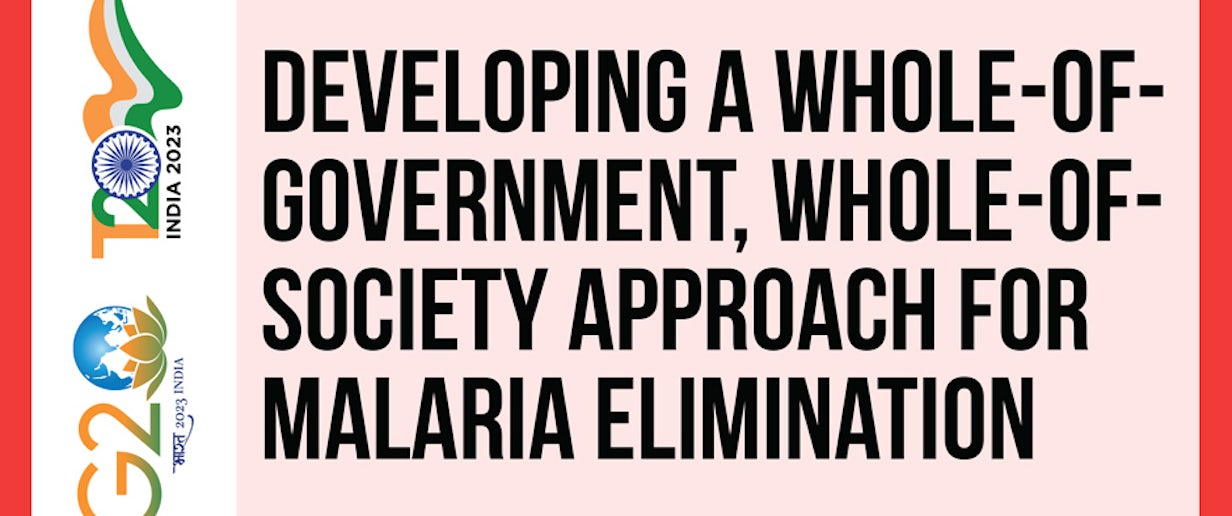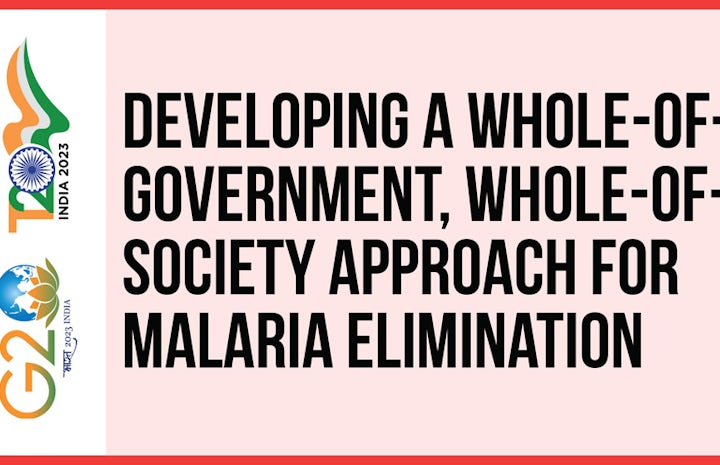Multi-sectoral approach is crucial in the fight against malaria
by APLMA •

T20 policy brief on holistic approaches to elimination
Globally, despite the decline in malaria incidence and mortality, vulnerable populations which are often located in rural and remote areas continue to be disproportionately impacted by this deadly disease.
Ahead of the recent Summit for Think20 India 2023 (T20), the Asia Pacific Leaders Malaria Alliance (APLMA) and the African Leaders Malaria Alliance (ALMA) co-published a policy brief on Developing a Whole-of-Government, Whole-of-Society Approach for Malaria Elimination. The policy brief details our recommendation to the Group of Twenty (G20) to achieve the targets of Sustainable Development Goals (SDG) target 3.3 of ending malaria and other communicable diseases.
“Ending malaria requires both an inclusive bottom-up approach to implementation and a top-down strong multisectoral commitment with unified efforts and enabling environments between health workers, civil society and private sector. Understanding the positive and negative impacts of all stakeholders across all sectors is key for achieving the SDG goal of malaria elimination by 2030.”
The challenge
With just seven years remaining to achieve the SDG targets, malaria-endemic countries continue to face challenges pertaining to disproportionate malaria burden, imported malaria, risk of resurgence and economic impact across sectors and society continue to pose a threat to the achievement of health-related goals of the SDGs.
Furthermore, the socio-economic and development cost of malaria affects a broad swatch of sectors and industries such as agriculture, mining, manufacturing, education, and tourism. For example, malaria endemic areas are estimated to receive 48% fewer tourists than those without malaria, resulting in approximately US$3.5 billion in lost tourism revenue globally each year.

Potential solutions
Multi-sectoral collaboration
“An integrated approach is needed to achieve malaria elimination. Coordinated and collaborative efforts from governments and all societal levels can help to strengthen health systems through surveillance and data management, empowering communities, and collaborating across borders to share data while fostering resilience to counter other disease threats.”
Cross-sectoral efforts require malaria to be viewed through the lens of society, human and environmental behaviours, health equity, industrial growth, and sustainable economic development and inclusive growth. Extensive dialogue and evidence-informed tools are necessary to identify opportunities and entry points for policy and programmatic changes within each sector that can contribute towards specific goals and malaria elimination efforts. Additionally, these cross-sectoral needs must be recognised in the national strategic plans for malaria to ensure an alignment of proposed policy reforms and programmatic needs.
There are already examples of such multi-sectoral collaboration. Launched in 2021, India’s One Health consortium aims to bring together animal, human, and environmental health stakeholders towards researching, developing, and equipping the country with best practices, roadmaps, response mechanisms and management needed to prevent zoonotic diseases, such as bird flu and rabies. Additionally, in Sub-Saharan Africa, governments, malaria partners, the Global Fund and Unitaid collaborated to launch a catalytic investment for improved bed-nets called the New Nets Project and Nets Transition Initiative.
Malaria-inclusive policies
Underpinned by the concept of ‘Health in All Policies’, line ministries bring together various sectors including the private sector and development partners to systematically take into account the implications of their policy decisions on malaria transmission, recognise the existing synergies, and share accountability for a malaria-free population. This requires every sector to proactively include prevention, surveillance, vector management, diagnosis and treatment as part of their sectoral plans in a cost-effective, efficient, and integrated manner.
“The need for integrated efforts and the role of other public and private entities and sectors cannot be overemphasised. For example, agricultural fields can potentially act as a breeding ground for mosquitoes even though agricultural production is critical to food security and economic growth, both in Asia and Africa. It is critical that we further strengthen multisectoral coordination in the endgame to defeat malaria."
As malaria and other communicable diseases impact large parts of public life, they must be included in policy planning beyond health programming. For example, malaria-inclusive policies need to be considered within the agriculture sector as certain food production practices or externalities (i.e., irrigation reservoirs and deforestation) may create favourable conditions for malaria vectors. Additionally, the use of herbicides and pesticides may cause insecticide resistance, a major challenge in malaria-endemic countries.
Similarly, there is a clear link between the education level and malaria-related morbidity and mortality. Low education levels substantially add to the compounded effect of socio-economic risk factors and increase exposure to malaria vectors. To change this, one example is the Malaria smart school programme in Uganda being piloted to incorporate malaria education into the school curriculum.
Conclusion
"Reaffirmation of commitment at all levels of government and ministries is crucial for countries in Asia Pacific to stay the course to end malaria by 2030. This can be done by establishing national task forces and committees to provide oversight and policy guidance to disease elimination programmes, including malaria. Strong political and financial commitment is critical to maintaining momentum to realise the goal of a malaria-free Asia Pacific.”
Countries must adopt a whole-of-government approach by reinvigorating inter-ministerial task forces to address cross-sectoral challenges in malaria elimination. Development partners, the private sector, youth, and communities are critical players that can influence government’s responsiveness in defeating malaria. Political will, targeted interventions for rural, high-risk and border areas, as well as having the right infrastructure in place, will all be fundamental to achieving the malaria elimination agenda. A disease threat anywhere, is a threat everywhere. Malaria does not know borders. No one is safe until everyone is safe.






